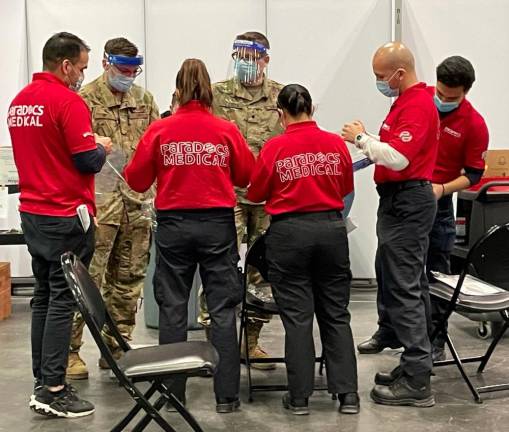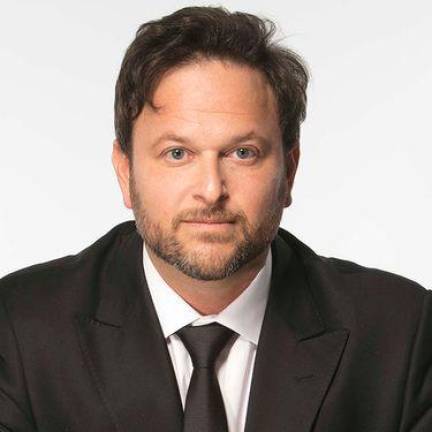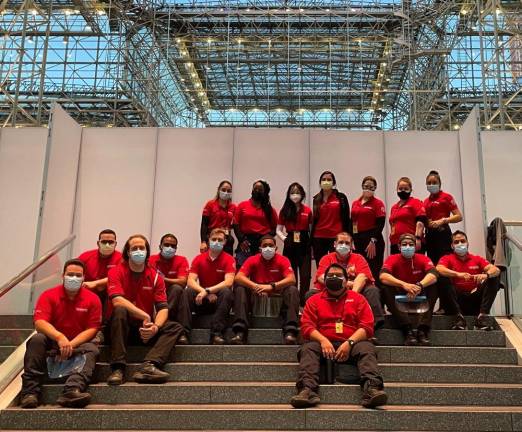From the Back of Ambulances to the Javits Center
ParaDocs founder and NYC EMT Alex Pollak on administering COVID shots at the mass vaccination site



Alex Pollak knew he wanted to be a paramedic back in high school in his native Queens. Working full time in the finance world, he could have never imagined that his part-time gig would lead him on a career path that is so vital to our city. After a fateful subway encounter, the idea for his startup ParaDocs was born.
The now-worldwide company, which Pollak launched in 2011, staffs pretty much every large event in New York City, like Governor’s Ball and New York Fashion Week, and venues such as Citi Field and Barclays Center, with on-site medical professionals. When COVID hit, they were able to pivot and bring much-needed assistance to New York, working with FEMA to provide temperature and wellness checks nationwide at essential businesses and COVID testing at events that were still happening such as the Inauguration, the Emmys and the Grammys. And in March, when the Javits Center started the Johnson & Johnson nighttime vaccine rollout, their trained professionals were called up to administer it.
In July, Pollak was selected by the Mayor’s Office of Citywide Event Coordination & Management as an inaugural member of its Citywide Events Advisory Group. It was staffed with leaders in the city’s events arena who brainstormed on best practices for reopening events safely.
How did the idea for ParaDocs come about?
My cousin was on a subway and he overheard two women talking about where they were going to get a paramedic last minute for a fashion show that they had. And he gave them my number and said, “My cousin’s a paramedic.” So I worked the show myself. Right time, right place. A few months later, a security company said they got a big contract that they needed a steady EMT, but I had a full-time job, so I told them I couldn’t do it. They asked me to help them staff it and I did and then they started asking about insurance, so I bought a small insurance policy and then it kind of just snowballed.
Tell us the events you staffed pre-COVID.
Everything. Governor’s Ball, Electric Zoo, Formula 1, Citi Field, New York Fashion Week. Basically anything. All over the country. We did all the big music festivals, concerts, stadiums.
Are you there yourself at these things or do you just oversee? Are you set up in a tent?
I’m there myself at a ton of them. It depends what type of event it is. There are regulations in some of the states. So if it’s a larger music festival, then the state says how many tents and how big the tents are and how much staff you need to have. So that’s what we basically specialize in — setting up a mobile emergency room in the middle of nowhere. So a music festival in New York probably has three or four medical tents — one is really large with doctors and very advanced care and then there are smaller ones, which are kind of like an urgent care that doesn’t need a doctor, you’ll have a nurse there, overseeing everything.
Explain how you had to pivot with COVID and what you’re doing now.
Our business was based around the events industry, which was the first one to go and is going to be the last one back. In March, we had our last big music festival in Florida. COVID was just starting to pop up, and then we came back and one after another, the venues and festivals started shutting down, everything just started canceling, so we literally went from 2020 was going to be our biggest year by far to it totally disappeared. So we started working during the pandemic. We worked for FEMA in New York because that’s where our home base is. Then we started temperature checks and wellness checks at some of the essential businesses that were still open. So we did government buildings, FreshDirect, ShopRite, we were taking temperatures and asking wellness questions and making sure people were wearing their masks and sanitizing. Then we started doing a ton of COVID testing. We do COVID testing for almost every major event out there. And now we’re doing vaccines as well.
How many people did you have on staff at the Javits Center?
We had about 60 people for 24 hours. We did for about a month when they went to the overnights ... We stopped about three weeks ago. They were only open four nights for overnight. On a Thursday night they contacted us and said, “Hey we need 60 people for Friday overnight.” And we thought it was going to go forever, but it ended after four days. But we were still staffed up for the rest of the month because they told us since we did such a good job on the overnights, if we could do the days as well.
As a paramedic, was there special training you went through to administer the vaccine?
There’s on-site training. We know how to give injections. We give injections in the back of moving ambulances, so it’s pretty easy to do it sitting around. They talk about the questions you have to ask, what you have to look out for afterwards, because you have to sit in the observation area for 15 minutes. Basically they take you through a list of questions, make sure that the patient’s verified and gets entered into the system correctly. But the support’s all there. So usually the patient comes in, does the registration in the front, gets escorted to the table by the National Guard, and then there’s a registration person behind the desk. There are two people giving the shots, one on each side, and then the registration person sitting in the middle that takes the information and fills out the card.
What was it like to give it to people?
It was actually really cool. It was the first release of Johnson & Johnson — now it’s [on pause] — which a lot people were actually waiting for ... So people were super excited about getting it and thankful. It actually was run extremely well. It’s like clockwork. It was very military, which is great. I was there all the overnights. Our shifts were 7 p.m. to 7 a.m. and then there was a 7 a.m. to 7 p.m. and then there’s a two-hour gap in the middle because of the switch from Johnson & Johnson [at night] to Pfizer during the day.
Do you have any interesting stories that stand out from your time there?
I don’t want to scare people away, but there are actually mats underneath each table in case people pass out. But it’s mostly just because people are scared of shots. They don’t actually have a bad reaction ... I had one patient who said she was just allergic to a bunch of stuff and if you’re nervous and have allergies to something that isn’t contraindicated, that you could go to one of these little, private rooms that they have for emergencies. She thought she was having a reaction; she wasn’t.
You were asked to serve on the Citywide Events Advisory Board. That us what that entailed.
Before any large event that happens in New York City, unless it’s by a fixed venue like Barclays Center, you have to apply for a permit from the city and state. So the city has their own regulations — close off the street, you’re going to have noise, there’s going to be celebrities — they have different rules. You have to provide your own security, your own porta-potties. And then the state also has rules. The state rules are for 5,000 people and above, you have to provide your own medical services, so you don’t just pick up the phone and call 911 every time. Because it is a medical crisis, they leaned very heavily on our expertise, because they wanted to know about scenarios like how do we open events with the pandemic? Or as the pandemic’s ending, how do we open events safely.
You were a first responder on September 11th. Where were you at the time?
I was actually by my next-door neighbor’s house in Queens. She had called because she had a nosebleed. And when we heard the call coming over the radio, we got an ambulance and headed straight to the World Trade Center. We heard it on the radio that they wanted two ambulances to come from every neighborhood. We were driving down the West Side Highway when we saw the second plane hit the second tower. The first day, I was there for about 14 hours. And then the second day I was there for about 12, but I didn’t see any patients the second day. The first day I saw a bunch of patients and I took six to the hospital in an ambulance and I treated some patients on-site.
To learn more, visit www.paradocsworldwide.com